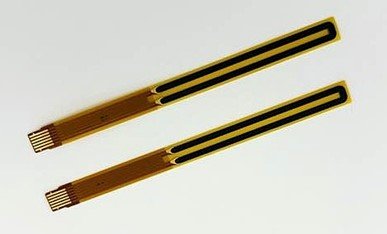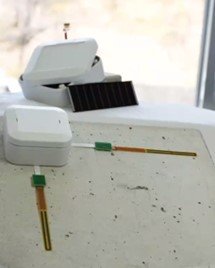MEKTEC, The University of Osaka, and Partners Begin Trials of FPC “Strain Sensor” for Real-Time Infrastructure Monitoring
NOK Corporation (Headquarters: Shibadaimon, Minato-ku, Tokyo; Representative Director, Group Chief Executive Officer: Masao Tsuru; hereinafter referred to as “NOK”) today announced that its Group company Mektec Corporation (Headquarters: Shibadaimon, Minato-ku, Tokyo; Representative Director, President and Chief Executive Officer: Taro Ito; hereinafter referred to as “MEKTEC”) has developed a new flexible printed circuit (FPC) “strain sensor.” The sensor, created through joint research with Associate Professor Teppei Araki and his team at the Institute of Scientific and Industrial Research, Osaka University (Ibaraki City, Osaka), can detect minute strains in infrastructure in real time. Demonstration trials began on August 25, 2025, focusing on railway and road infrastructure in Shiga Prefecture.
This demonstration project is being conducted as part of the “Futuristic and Intellectual Co-Creation Town(FICCT)” program led by the Institute for Open and Transdisciplinary Research Initiatives, The University of Osaka, where Araki serves as Deputy Project Leader. MEKTEC is the sole private-sector executive institution participating in the program, and, with the cooperation of HAKATTE Inc., the Omi Railway Line Management Organization, and the City of Higashi-omi, is advancing the demonstration of advanced infrastructure monitoring technologies.
-

Strain sensor -

Example of strain sensor installation
Much of Japan's infrastructure, built during the period of rapid economic growth, is now due for renewal. Bridges, tunnels, and other structures across the country undergo mandatory inspections once every five years. This means checking around 730,000 road bridges and 10,000 tunnels*, a massive undertaking made even more difficult by the shortage of skilled inspectors.
The new "strain sensor" addresses this challenge by detecting subtle strains in concrete and metal in real time. By analyzing the data, it becomes possible to spot irregularities that are hard to catch with conventional visual checks. Through real-world trials and implementation, the project aims to establish a new, more efficient way of managing infrastructure.
Source: Ministry of Land, Infrastructure, Transport and Tourism, White Paper on Land, Infrastructure, Transport and Tourism 2025
Background and purpose
Maintaining aging infrastructure requires regular inspections to quickly identify areas in need of repair. Regional railways are no exception, and with fewer engineers available to operate and maintain them, these systems face challenges to long-term sustainability.
To address these issues, the “Futuristic and Intellectual Co-Creation Town (FICCT)” program treats railway infrastructure as a shared community asset and aims to create new value by adopting advanced technologies. As part of this program, the newly developed “strain sensor” detects abnormalities that are difficult to catch through conventional inspections, helping to improve the efficiency of infrastructure management and establish new methods of maintenance.
Overview of the demonstration project
・Start date: August 25, 2025 (Monday)
・Test sites: A large bridge in Higashi-omi City, Shiga Prefecture, as well as tracks and railway bridges on the Omi Railway Line
・Details: Strain sensors are installed on structures to continuously monitor their condition. The system collects and analyzes real-time data on subtle strains caused by vibration, or the expansion and contraction of metal and concrete.
FPC "strain sensor" for infrastructure management
The "strain sensor" is an FPC designed to detect changes in electrical resistance caused by vibration, expansion, or contraction. It was developed specifically for installation on concrete structures. Carbon is used as the conductive material, ensuring excellent resistance to corrosion and long-term durability. With practical application and mass production in mind, the sensor is manufactured using printed electronics technology, which places less burden on the environment compared with conventional FPC production methods.
Future outlook
The data obtained through this demonstration project will be applied to future infrastructure management. Early detection of abnormalities can help prevent disasters and accidents while also improving maintenance efficiency. MEKTEC plans to begin prototyping within FY2025 and aims to start mass production by 2030. Through its FPC technology, the company is committed to developing safer and more sustainable social infrastructure.
About the Co-Creation Program “Futuristic and Intellectual Co-Creation Town (FICCT)”
This program is led by the Institute for Open and Transdisciplinary Research Initiatives, The University of Osaka, as an industry-government-academia collaboration. It brings together local residents, municipalities, companies, and researchers to promote the social implementation of sustainable infrastructure management based on science and technology. Since 2022, the program has been supported by the Japan Science and Technology Agency (JST). MEKTEC has been participating since 2021.
About HAKATTE Inc.
HAKATTE Inc. is a university-based startup founded primarily by researchers involved in the “Futuristic and Intellectual Co-Creation Town (FICCT)” program. The company’s mission is to bring smart infrastructure monitoring into real-world use by integrating advanced materials technology with information processing technology. HAKATTE is dedicated to realizing the smart transformation of regional cities and the realization of sustainable local communities.
For inquiries related to this press release
Corporate Communications, Corporate Affairs Group, CEO Office, NOK Corporation
TEL: +81-3-5405-6372
Mail: mb_nok_corporate_affairsjp.nokgrp.com